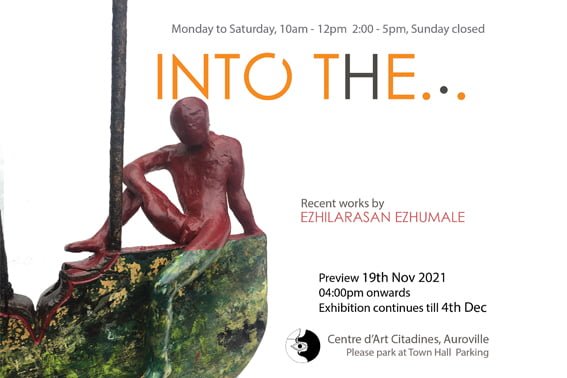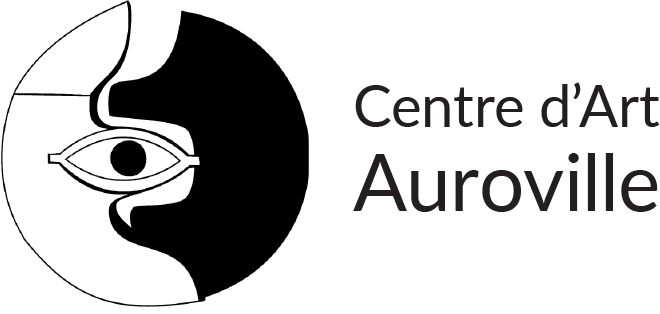BY ezhilarasan ezhumale
19th November to 4th December 2021
Monday to Saturday 10am-12pm & 2pm-5pm
Opening on Friday 19th November at 4pm

“A Place for People”
Time and again in art, the dominance of abstraction has resulted in the return to the human form. This is the case within E.Ezhilarasan’s own artistic journey. Having worked in the past with a language that would be classified as “abstract” or “semi-abstract”, in his current series of works the figure returns emphatically. The reasons for this shift are the urge to capture the human condition and the moments that make us human. One could also situate this transition against the larger backdrop of the artist’s own growing socio-political consciousness as well as the conditions brought on by the pandemic- isolation, loss of livelihood, man-animal conflict, changing patterns of consumption and the process of othering people based on their identity.
As a visual artist who also has his roots in theatre, there has always been a strong experiential aspect to his work. Experiences that left their mark on the artist’s being were absorbed, digested and manifested on the canvas through form and colour. In his current series of work, his observation of experiences, in particular those of agricultural workers, forms the central theme. However, this is not only the experience of others but that of his own self too. Having been involved in farming for many years, the rhythm of the earth and the rhythm of the body that works the earth is one that the artist is intimately familiar with.
These experiences transform into works of art mediated by a receptive material. Working with NCL blocks used for construction, he chisels anthropomorphic forms that like the material itself, speak of the resilience and strength of those involved in farming. Some of his sculptures are also made with M-Seal, a material that lends itself to spontaneous sculpting methods. Here, the quiet relaxation that comes with moulding and shaping a pliable material complements the sentiment of the works. The process of tilling, sowing, nurturing, harvesting and selling the produce might be demanding. Yet, contrary to popular perception, there is also joy in such a life. This aspect is portrayed through figures that rest, relax and contemplate amidst their own immediate environment. In a world that searches for an elsewhere space where such experiences are to be found, his characters show that such transformative moments can be present in the here and now.
The human body is an index of the mind. Ezhilarasan therefore observes and highlights aspects of the human body, its movements, reflex actions and postures that reflect states of mind ranging from repose to strength. In his works, the body and mind, that are in synchrony with each other, are also at ease in the environment they occupy. Figure and the environment, some of which is created with materials found in the artist’s immediate surroundings, intermingle infusing an element of abstraction to the figure and at the same time expanding the limits of human form. As against a life that is reduced to the miniscule dimensions of the smartphone, his characters belong to the cosmos.
The larger backdrop that informs Ezhilarasan’s thought process is a way of life that is hinged on technology, the smartphone, online shopping and an angst for consumption that leaves no space for nature. His works are spurred by developments such as the arrival of corporates into agriculture and the presence of middle-men/platforms that divest farmers off their individuality and right to livelihood. Foregrounding farmers who are presented in their natural surroundings, in particular, his works address a generation of people who have seldom seen a farmer or realise that the polished rice they eat was once a stalk of paddy.
An enquiry into the frames that define vision connects Ezhilarasan’s works centred on farming and the series of portraits in charcoal. Just as his sculptures present an alternative to the popular imagination of how a farmer looks or what their life might be like, his portraits present an alternative to the perceptions of the Muslim community and their activities. Viewed both in general and in particular during the pandemic with suspicion, his portraits set out to counter this framing. To do so, he uses the idea of everyday life as a powerful tool. Portraits of individuals, smiling as they go about their everyday life, is used to establish a shared ground of humanity. Furthermore, he depicts people of varied gender, age and backgrounds to highlight their individuality as against the popular perception of a monolithic community. Interestingly, while being inspired by individuals within his neighbourhood, the portraits are only loosely based on them. Instead, his strategy is to observe people, allow this observation to become part of his memory and then manifest this memory that is now part of his being on the paper. In other words, the pictorial space is a culmination of the interactions between the self and the other that have taken place over space and time.
Space is the overarching concern in Ezhilarasan’s body of works, both then and now. In his earlier works, his concern was conveying the experience of journeying through natural and man-made spaces. He now takes a new thematic direction within this subject by exploring the experiences of those who occupy the margins of these physical, social and cultural spaces. This exhibition thus demonstrates the organic evolution process of an artist who is delving deep into a subject and through that arriving at new points of departure.
Text by Vaishnavi Ramanathan art historian/curator
